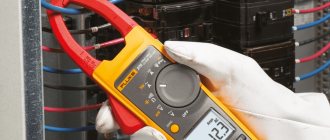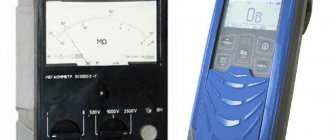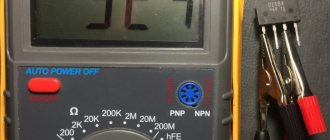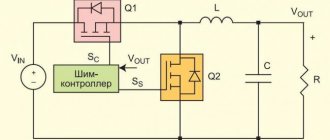Attention! Lots of text.
When preparing the car for winter, I asked myself the question of checking the battery for the upcoming cold weather and, if necessary, the possibility of charging.
And in particular, charging a maintenance-free battery, because... This is exactly what our cars come from the factory. Since I am a complete layman in this matter, I began to study the Internet. I bought a multimeter and have a charger. And after the manipulations I carried out according to the manuals that I dug up, I decided to duplicate them in my blog so that they would not get lost, forgotten or deleted by the authors. I will leave links to articles below. This presentation is not a guide to action; I do not impose these measures on anyone, and I do not bear responsibility for the accuracy and quality of what is stated.
You do everything below at your own peril and risk. I urge you to filter all the information available here. To check the battery voltage we need a multimeter. The most common and inexpensive looks something like this:
For clarity, I found a picture where all the values of the multimeter are written
1) Battery voltage measurement
To measure voltage with a multimeter, you need to turn it on in the constant voltage measurement mode, and set the range above the maximum voltage value on a charged battery; a charged battery has about 12.7 volts, so choose DCV, 20 volts. Next, you need to connect the black probe of the multimeter to the minus of the battery, the red probe to the plus of the battery and take readings from the multimeter display.
2) Current leakage measurement
First you need to set the Multimeter to current measurement mode at 10 or 20 Amps.
How to determine current leakage into the positive gap: Disconnect the positive terminal from the battery. Connect the ammeter with the negative terminal - to the contact terminal of the car. The positive terminal - to the battery.
I hope my post will help someone and save them from having to scroll through the Internet looking for information. Here we consider only the main points of working with a multimeter and a car battery. And the capabilities of the multimeter are very extensive, it’s not for nothing that it was called MULTI, which means a lot.
ABOUT CHARGING THE BATTERY
Preface.
It is worth noting that old batteries (5 years old) should not be charged or reanimated using any old-fashioned methods. Firstly, it is useless or will only give a short-term effect, secondly, it is unsafe. Its life is coming to an end, and it would be wiser to recycle it. Charger requirements. Batteries that do not need to be topped up with water should be charged only with devices that automatically maintain the charging voltage, and preferably automatically limit the charging current. Naturally, OBSERVE THE POLARITY OF CONNECTING THE CHARGER AND BATTERY! THAT IS “PLUS” to “PLUS”, “MINUS” to “MINUS”! (after all, not every charger has “foolproof protection”) DON’T FORGET THAT THE ROOM SHOULD BE VENTILATED, because the gases released in this case are harmful to health, and arsine, sulfur dioxide, hydrogen chloride are also released, which when mixed with oxygen in a certain proportion it forms an explosive mixture (well, if suddenly you want to set up a battery charging station at home, and simultaneously charge a dozen batteries :)))) The costs of purchasing an automatic charger are not justified, so it is better to look for WHERE you can use it once. A good device will determine the condition of the battery and select the required charging current. An excellent charger on the Internet will cost around 6-8 kilo rubles. And don't forget to clean the battery from dirt before experimenting with it. Dirt on the battery will conduct current (bypass the charging circuit), which is not good at all. And also, the battery begins to more or less accept a charge only after the electrolyte has warmed up to a positive temperature, so when you bring the battery home from the cold, let it “settle” or warm up, as you understand better. Peculiarities.
The difference between serviced and non-serviceable is the availability of plugs for filling electrolyte.
The developers made sure that this was not necessary. However, in a non-serviced one, it is possible to remove the cover and get to the plugs. But, as a rule, there is no point. It lasts for a lifetime. Yes, any maintenance-free battery should have holes on the sides to vent gases and normalize pressure. When charging a maintenance-free battery, DO NOT allow the voltage at its terminals to rise to more than 15.5 volts. The point here is in the physics of the process. The battery itself will take as much current as it requires to charge. Just for charging. What you push into it beyond that, by increasing the voltage, it will send mostly for electrolysis of the water that is in the electrolyte, and a little more for heating. That is, it will simply decompose water into oxygen and hydrogen at your expense. Distilled water is not in short supply. But you cannot add it to a maintenance-free battery. The amount of electrolyte will decrease irreversibly, and its density will also increase irreversibly (the water is gone, but the acid remains!) There is another danger - if your battery is heavily discharged (the so-called “deep discharge”) and all the acid has gone into the plates, then It is IMPOSSIBLE to start charging it immediately with the rated charging current. There is water between the plates and you will simply electrolysis it. Therefore, if the battery is charged with a current of tens of amperes, in a short time, the charge will “stick” to its surface and will not allow the electrolyte to penetrate into the thickness of the plates. And in the case of charging with a low current - a few amperes - it will restore the charge throughout the entire thickness of the plate. The term "charge" - here somewhat formal - is the nature of the distribution of lead sulfate throughout the thickness of the plate. How to charge.
1) Determination of charging current.
The charging current should not exceed 1/10 of the battery capacity. For example, if you are interested in how to charge a 12 V 55 A/h car battery, then be sure to keep in mind that the charging current should not exceed 5.5 A. If the battery is deeply discharged, you need to charge it with a small current (1.5 - 2 ,0 A). If you are sure that the battery has not been deeply discharged, connect it to the charger, observing the polarity (see above). The charger (charger) must be in the off position. If the device has a voltage regulator, set it to the minimum voltage. Turn on the charger. Set the charging voltage to 14.4V. The process has begun. 2) During the charging process, the current will decrease. The process will end when the voltage at the terminals is 14.4V and the current drops to 200mA (i.e. 0.2A). It is impossible to overcharge or damage the battery with this voltage. The charging current will simply drop to the value of the self-discharge current of the battery. IMPORTANT: A current that can be considered safe for a battery is numerically equal in Amperes to about 1/20 of its capacity in Amperes/Hours, that is, for a 55 Ah battery this is a current of 2.75A. A current exceeding 1/5 of its capacity in Ampere/hour can be considered dangerous, that is, for a 55 Ah battery this is a current of 11A. Strictly speaking, when she can, she herself will “eat” even more - but only in certain modes and from the same 14.4V at her terminals. But if you use the handle of the charger to increase this voltage and overclock it so that 11A comes through the battery - it will most likely be far from 14.4V... PROHIBITED! The rated charging current has traditionally been considered for half a century to be a current equal to 1/10 of the battery capacity in Ampere/hours, that is, for a 55 Ah battery this is a current of 5.5A. For maintenance-free batteries, the main charging characteristic should be considered not current, but VOLTAGE. The current helps evaluate the process occurring in the battery. 3) In the case of a deep discharge, in this case it is necessary to charge the battery with a reduced voltage (12V.13V), and at the same time it is necessary to ensure that the current at the beginning of the charge does not exceed that same 1/20 of its capacity in Ampere/hours (in principle, this should happen automatically, unlike the situation when 14.4 V is immediately supplied to the terminals). If there is more, reduce the tension even more. The current will gradually increase - this is normal. This acid comes out from the depths of the plates, lead sulfate gives an influx of acid, the density of the electrolyte increases, and the battery is charged. When the current rises to 1/10 of the battery capacity, or even more, and it’s very good - when after this rise it even begins to decrease - then you can switch to the charging process described above, i.e. set the voltage to 14.4V. Now additional information
for those who doubt it, such as “why should batteries that do not require topping up water be charged only by devices with automatic maintenance of charging voltage?”
When charging using this method (charging at a constant voltage), the degree of charge of the battery at the end of charging directly depends on the magnitude of the charging voltage that the charger provides. So, for example, in 24 hours of continuous charging at a voltage of 14.4 V, a 12-volt battery will be charged by 75-85%, at a voltage of 15 V - by 85-90%, and at a voltage of 16 V - by 95-97%. The battery can be fully charged within 20-24 hours with a charger voltage of 16.3-16.4 V. Therefore, in OUR case (maintenance-free battery) for a satisfactory (90-95%) charge of modern maintenance-free batteries using commercially available chargers devices with a maximum charging voltage of 14.4-14.5 V will require more than a day. And to fully charge a battery of this type will take longer than to charge a low-maintenance or regular one. At the beginning of the charging process, the current sometimes reaches 40-50A, and therefore all chargers must be equipped with circuits that limit the charging current within 20-25A. The charging time depends on the level of discharge and can take up to THREE days. How to determine the state of charge of a non-maintained battery and its density.
This is most likely impossible to determine 100% accurately.
It is possible only with some degree of probability, or approximately. The method for determining the degree of charge by voltage is valid only for batteries that have been in a stationary state for at least 8 hours. The measurement must be made no earlier than 8 hours after turning off the engine. For a fully charged battery, the value is 12.7 - 12.9 Volts at a temperature of +20...+25 °C. Read also: Melting point of bronze in degrees
In some cases, car enthusiasts begin to wonder how to check the charger for a car battery. After all, you have to charge the battery not so rarely, especially in winter. The speed and reliability of this operation primarily depends on the efficiency of the charger. Checking its functionality will not take you much time. It should also be noted that different types of devices show different effectiveness. The reason for this is the different settings of the chargers. To properly test, you just need to know how the device works.
How to check a car battery charger? To do this, you just need to understand how it works. Without this, it is not only impossible to check the device, but also to use it correctly, in the case of manual control.
If we consider the charger device, it consists of a transformer and a rectifier. The output voltage is 14.4 V. This figure will surprise many car enthusiasts. After all, your battery voltage is 12 V, why use a higher voltage for charging. The fact is that a discharged battery does not pass through itself a voltage of 12 V or lower. Only higher current voltage levels should be used for charging. In this case, it will pass through the electrolyte and charge it.
Through many years of experiments, it was found that the most optimal option is a voltage of 14.4 Volts. It allows you to charge the battery with maximum efficiency and does not damage it. Higher current is quite dangerous and can lead to rapid battery failure.
When the battery is connected to a power source, the process of restoring its capacity begins. In the process, the internal resistance changes. Therefore, as the charge level increases, the charging current decreases. In theory, when fully charged, the current should drop to 0 and the battery voltage should rise to 13 V. Taking into account some of the features of batteries, they should be charged with a current not exceeding 10% of the total capacity.
Read also: How to charge an alkaline battery at home
It is calculated like this:
if the battery has a capacity of 70 Ah, then the maximum charging current is 7 A. In this case, the charging time will be 10 hours.
During operation, the current strength will constantly decrease. On automatic devices this happens without human intervention. On models with manual control, you will have to make the adjustment yourself. Some drivers, in order to speed up the charging process, increase the charging current.
This is not recommended
. At high current levels, the risk of damage to the battery plates is much higher. But, in rare cases, the current level can be slightly exceeded. This allows you to reduce charging time by a third. But you should be as careful as possible. At the first signs of electrolyte boiling, you should immediately reduce the current level. The high current charging method cannot be used on automatic chargers.
Examination
It is worth paying attention to the technical characteristics of chargers, so you can understand the principle of checking it. Some car enthusiasts rely on the readings of devices installed on chargers. But this does not give any guarantees; they may well be “knocked down” and give erroneous readings. Therefore, it is advisable to periodically test the charger for performance.
The first check will be to measure the voltage. To do this, connect the charger to the battery. At the same time, the voltage on the crocodiles is checked. It should be equal to 14.4 V, and in no case fluctuate. Any deviations are considered a sign of malfunction. If the voltage is lower, but not much. For example - 14 V, then it is quite possible to use this device further. Just take this feature into account and do not try to charge completely discharged batteries.
If the voltage is below 13 V, it is not advisable to use the charger. Also, when the voltage increases above the normal value, it is not recommended to use a charger. This may cause damage
The next step is to check the current strength. To do this, you will need an ammeter or multimeter that allows you to measure current. It is connected to one of the arms of the charger; in other words, current is supplied to one of the terminals through an ammeter.
There are several ways to measure the supplied current and monitor the operation of the charger. Most often, they check the coincidence of the readings of the built-in devices and the actual current strength. To do this, simply plug the charger into the network with an ammeter connected to it. And compare the instrument readings. You can also control the charging progress, both on simple manual devices and on automatic ones.
Checking the correct operation of automatic chargers is carried out as follows. A completely discharged battery is taken. The charger is connected to it via a multimeter. The current supplied to the battery is checked. It should be equal to 10% of the battery capacity. In case of any deviations, the device is considered faulty.
How to connect correctly
In such a question, how to check ammeters with a multimeter, you need to be guided by the recommendations below:
- Calculate the range for measuring indicators. The battery has 1.5V, 7.5V and 12V. The value is set slightly higher than normal. This will be a reserve that will prevent damage to the device.
- Correctly determine the direction of the current, i.e. polarity of the terminals on which the measurement will be performed. The generally accepted designations indicated on the body are taken as a guide.
- Proper connection of the probes is necessary. Black - negative, placed in a general type socket called COMMON (COM). Positive - installed in the red connector.
Scheme of further actions:
- The device is adjusted to the desired measuring range.
- The value is set 10% higher than expected.
- If the indicator is unknown, then the maximum is taken as the extreme value.
- The probes are installed according to the scheme corresponding to the type of measurement being performed. Red to connectors where current, voltage or resistance are measured. Black to common connector.
- The probes are brought to the device being tested or the power supply network. Red is placed on a plus, black on a minus.
- It is necessary to evaluate the obtained indicators. It may be necessary to initially adjust the position of the pointer (“to zero”) to make the information more reliable.
Repair
If you identify deviations from the norm, you should begin troubleshooting. To do this, you need to disassemble the device and check its components individually. Do not forget to disconnect the device from the mains before starting work.
First of all, check the diode bridge. To do this, voltage is applied to the memory. Current must be present both at the switch terminals and after the bridge. If this does not happen or the readings differ from the norm, you need to check all the bridge diodes individually. Serviceable ones should show a small resistance on one side, and on the other hand the resistance should tend to infinity. Replace any faulty diodes.
Automatic chargers have an additional board that regulates the operation of the device. It is checked quite simply. They simply measure the output voltage. If it is absent or significantly below the norm, then check the components individually or replace the entire board. The cause of unstable voltage is a breakdown of the capacitor.
Most often the transformer fails
. It is checked by ringing the primary winding. A working transformer should have a resistance of 20-30 ohms. In the event of a breakdown, this indicator usually tends to infinity. If it malfunctions, it is impractical to restore the charger. The cost of a new transformer is usually equal to the purchase of another charger. If you have extensive experience in electrical engineering, you can try to restore the winding. To do this, you will have to remove the old winding and wind a new one. But keep in mind that rewinding does not always help.
Read also: How to make conductive varnish with your own hands
Conclusion
. As a rule, the average car owner is faced with the need to charge a car battery several times during the winter. To do this you just need to have a good charger. But, the question often arises of how to check a charger for a car battery. After all, this electrical device does not always work perfectly. Therefore, it is advisable to periodically check that it is working correctly.
In recent decades, many devices have appeared that use rechargeable batteries or DC batteries to ensure autonomous operation. These are power tools, telephones, computers, and various household appliances. Each of them usually comes with a charger to keep the battery in working condition. Unfortunately, situations often arise in which the battery does not charge at all or discharges very quickly. One of the reasons for such phenomena may be a malfunction of the charger (charger).
Safety precautions
It's easy to check the current strength. It is enough to connect the multimeter in accordance with the operating rules. It is necessary to follow the instructions in order not to violate safety precautions:
- The device is connected in a de-energized state.
- Pre-inspect the insulation on the wires. With a long service life, its integrity is compromised. There is a possibility of receiving an electric shock.
- You only need to measure amperes while wearing rubber gloves.
- Measurements are prohibited in rooms with high humidity. Moisture has high electrical conductivity. The risk of injury increases several times.
- Anyone who has suffered an electric shock, regardless of its power, must be urgently taken to the nearest medical center. It is forbidden to work with electricity alone. In an emergency, your partner can call an ambulance.
- It is strictly forbidden to work with devices that spark or are broken when connected to analog power sources, for example, to a battery, batteries or power supply. All this can lead to electric shock. Not too strong, but capable of harming the human nervous system and heart.
- It is forbidden to use a multimeter after an impact, just as it is forbidden to glue it with tape or insulating tape. It is better to use a new device or entrust it to a specialist for repair and testing for suitability.
After using the multimeter device, the cables that were cut are connected with the circuit de-energized.
A multimeter is a device that is simply impossible to do without in everyday life and other areas. Having even the most minimal knowledge of its operation, you can repair the devices. Knowing the indications, it is easy to determine their unsuitability.
Principle of operation
The operation of the charger is based on reducing the voltage and converting alternating current to direct current. For this purpose, the circuit contains a step-down transformer and a diode bridge. The charging voltage should be 5-10% higher than the nominal value of this parameter for the battery, and the charging current should be about 10% of its capacity. Sometimes the phone is recharged from the car's DC battery. In this case, rectification (conversion from variable to constant) is not necessary.
Amps and multimeter: what is it
Ampere is the SI unit that measures the force present in an electric current. Meters for determining it are called multimeters, which can be digital and analog or pointer.
There are differences between them. In the first case, the information is displayed on a liquid crystal screen, in the second there is a dial scale. An analog device has too high a measurement error. When working with it, you need to eliminate the slightest vibrations. Otherwise, the result may not be accurate. Digital more:
- comfortable;
- reliable;
- functional;
- practical;
- universal.
Examination
To check the functionality of the charger transformer, it is enough to connect a lamp in parallel with the terminals, the rating of which corresponds to the charger. You can check the presence of voltage at the terminals of the charger with a tester (digital multimeter).
A complete picture of the condition can only be obtained by checking the charger with a multimeter. Recharging occurs differently for different devices, and obviously the testing methods are different.
Mobile phones and computers
Checking the memory of a mobile phone or tablet computer comes down to measuring the voltage at the terminals. It must correspond to that specified in the instruction manual or sticker (marking) on the case.
The multimeter is set to DC voltage measurement mode if it does not support the auto-adjust function. Sometimes the contacts of the charger connector are so small that it is not possible to reach them with the probes of a multimeter. In this case, you can carefully use ordinary steel sewing needles. If in this case it is impossible to make a measurement, it is necessary to disassemble the charger housing and find the terminals to which the ends of the power cord are soldered.
Power tools and household appliances
Power tool batteries are charged using more advanced devices. Such memory devices usually have three outputs: two power and one control. The manager serves to transmit information about the battery status to the memory. When the nominal charge is reached or the battery overheats, the charger current is limited.
To check, the voltage at the terminals of the power contacts is measured. The check would end there, but there are cases when, with a working charger, the batteries do not charge, or it turns off very quickly without charging the battery.
In this case, it is necessary to measure the charging voltage with the battery connected. Since chargers are made with contacts protected from access by foreign objects, you will have to disassemble the case and solder wires to the terminals. Sometimes this is easy to do, but sometimes you have to make an effort by making grooves in the body with a sharp knife.
After this, you can check the charge with a multimeter using wires to connect. If the measured value fluctuates from nominal to zero, most likely the power contacts have weakened. If premature shutdown occurs, attention must be paid to the control contact.
If, after contact is restored, the battery is not fully charged, the reason is not in the charger, but in the thermistor installed in the battery itself.
How to check amps in different devices?
There are several types of verification.
In the charger
The charger must be checked if there is a need to determine the reason why it is faulty. The current strength is different for each specific device. For example, it is the same on phone and tablet devices, but much more on car devices.
For your information. The permissible limit is indicated on the product label or applied to the body as a marking.
The principle of operation is exactly the same. The difference is that with small pin sizes on the connector, it is difficult to connect probes.
How to measure amperes with a multimeter in a charger if the connector does not include probes:
- Steel sewing needles are inserted into the contacts.
- To do this, use pliers and put gloves on your hands.
- The probes must be connected to the tips of the needle through a load.
- If this is not possible, then you need to disassemble the unit housing. This way you can connect the probes to the output of the charger in the place where each tip of the electrical wire is soldered.
It is necessary to correctly follow safety precautions and pay attention to the recommendations from the manufacturer. In some products it is forbidden to open the lid, while others are completely disposable, that is, they cannot be repaired.
In battery
You can check the lithium-ion battery in your car by doing the following:
- The multimeter is set to voltmeter mode, which tests the voltage.
- Set the range to 0-20V.
- It is advisable to measure the battery only when the vehicle is disconnected from the power supply.
- The red probe is applied to the positive socket.
- The black probe is placed on the negative socket across the load.
- The readings obtained must be recorded.
Now you need to evaluate the result:
- Voltage = 12.6 volts. The device is suitable for use. There is no need to charge.
- The voltage is less than 12 V. The car battery needs to be charged. She was discharged.
- Readings are more than 15 V. Such a device is prohibited from being used. This will damage the generator. You need to purchase a new battery.
For your information. To get accurate data, you need to measure them 6 hours after disconnecting from the car.
In the power supply
It is quite possible to check the amperes with a multimeter on the power supply. The procedure is performed at break and a load is necessarily applied. The principle of operation is the same as when working with other equipment. It is only necessary to note that the power supply has high power. Accordingly, measurements are taken as quickly as possible, before the probe wires heat up.
As an example, it is worth considering the situation of studying the power supplies of a cash register, camera, cell phone, etc. In this case, a multimeter is needed to measure the current. This is necessary in order to understand whether the device is operational. In some cases, the output voltage may not always guarantee operation.
The study is done in discontinuity with the load:
- The tester mode switch must be set to the maximum value of 10 amperes.
- Measuring a power supply with a power of more than 10 amperes is prohibited with a conventional multimeter.
- Next you need to break the chain. If it is not possible to open the case, one core of the supply wires is cut.
- To complete the circuit, one wire is connected to the tester probe, and the second is connected to the supply circuit - the wire coming from the power supply. This is how the circuit is closed on the device using a multimeter.
- The battery acts as an energy consumer. It's completely discharged. The current strength will be twice the operating current.
- Gradually, with an increase in the charge level, you can observe a decrease in the current strength, tending to 0.
Even if the arrow does not move from the 0 mark, do not be alarmed. This does not mean that the device is broken.
Attention! A couple of seconds are enough to measure. If the voltage is 12 volts and the current is at least 3-5 amperes, then the wires can heat up to the point where they become charred. This can damage all units connected to the circuit.
In the car
To determine the suitability of a vehicle's generator for use, you need to check its charge level. The rules for using the device are the same as with a battery. If the data is incorrect, you need to check each component of the device:
- brushes;
- rings;
- diode bridge;
- voltage regulator;
- stator device;
- rotor.
Main types of ROM
All chargers, based on the principle of operation, are divided into two types: pulse and transformer . A pulse device operates due to the presence of a pulse current converter in it. And inside the transformer charging there is a simple transformer with a rectifier, due to which the ROM weighs more and looks more bulky than a pulse one. Pulse-type devices are considered more reliable in operation, but transformer-type devices are easier to maintain and repair.











